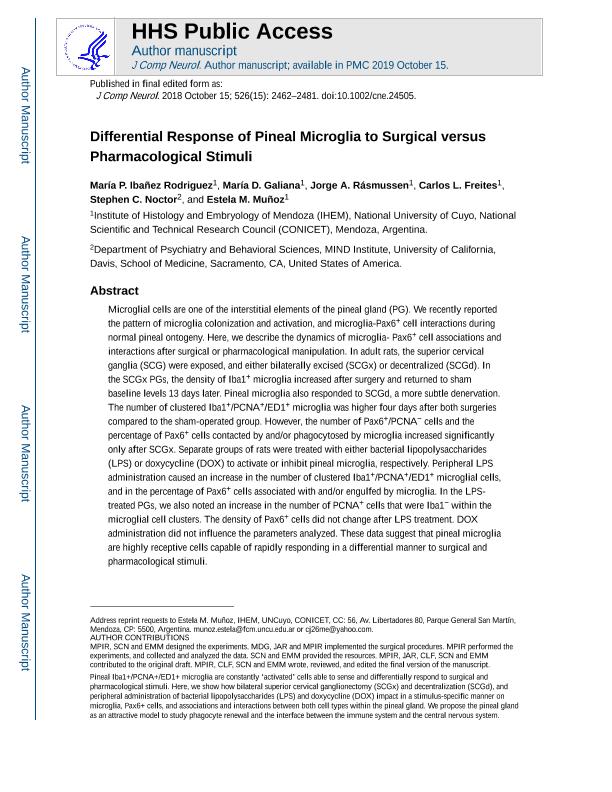Mostrar el registro sencillo del ítem
dc.contributor.author
Ibañez Rodriguez, María Paula

dc.contributor.author
Galiana, María D.
dc.contributor.author
Rasmussen, Jorge Ariel

dc.contributor.author
Freites, Carlos Leandro

dc.contributor.author
Noctor, Stephen C.
dc.contributor.author
Muñoz, Estela Maris

dc.date.available
2019-11-29T21:18:08Z
dc.date.issued
2018-10
dc.identifier.citation
Ibañez Rodriguez, María Paula; Galiana, María D.; Rasmussen, Jorge Ariel; Freites, Carlos Leandro; Noctor, Stephen C.; et al.; Differential response of pineal microglia to surgical versus pharmacological stimuli; Wiley-liss, Div John Wiley & Sons Inc; Journal Of Comparative Neurology; 526; 15; 10-2018; 2462-2481
dc.identifier.issn
0021-9967
dc.identifier.uri
http://hdl.handle.net/11336/91046
dc.description.abstract
Microglial cells are one of the interstitial elements of the pineal gland (PG). We recently reported the pattern of microglia colonization and activation, and microglia-Pax6+ cell interactions during normal pineal ontogeny. Here, we describe the dynamics of microglia-Pax6+ cell associations and interactions after surgical or pharmacological manipulation. In adult rats, the superior cervical ganglia (SCG) were exposed, and either bilaterally excised (SCGx) or decentralized (SCGd). In the SCGx PGs, the density of Iba1+ microglia increased after surgery and returned to sham baseline levels 13 days later. Pineal microglia also responded to SCGd, a more subtle denervation. The number of clustered Iba1+/PCNA+/ED1+ microglia was higher 4 days after both surgeries compared to the sham-operated group. However, the number of Pax6+/PCNA− cells and the percentage of Pax6+ cells contacted by and/or phagocytosed by microglia increased significantly only after SCGx. Separate groups of rats were treated with either bacterial lipopolysaccharides (LPS) or doxycycline (DOX) to activate or inhibit pineal microglia, respectively. Peripheral LPS administration caused an increase in the number of clustered Iba1+/PCNA+/ED1+ microglial cells, and in the percentage of Pax6+ cells associated with and/or engulfed by microglia. In the LPS-treated PGs, we also noted an increase in the number of PCNA+ cells that were Iba1− within the microglial cell clusters. The density of Pax6+ cells did not change after LPS treatment. DOX administration did not influence the parameters analyzed. These data suggest that pineal microglia are highly receptive cells capable of rapidly responding in a differential manner to surgical and pharmacological stimuli.
dc.format
application/pdf
dc.language.iso
eng
dc.publisher
Wiley-liss, Div John Wiley & Sons Inc

dc.rights
info:eu-repo/semantics/openAccess
dc.rights.uri
https://creativecommons.org/licenses/by-nc-sa/2.5/ar/
dc.subject
BACTERIAL LIPOPOLYSACCHARIDES
dc.subject
DECENTRALIZATION
dc.subject
DIFFERENTIAL RESPONSES
dc.subject
ED1 (RRID: AB_566872)
dc.subject
GANGLIONECTOMY
dc.subject
IBA1 (RRID: AB_2224402; RRID: AB_839504)
dc.subject
MICROGLIA
dc.subject
PAX6 (RRID: AB_1566562; RRID: AB_2565003; RRID: AB_291612)
dc.subject
PCNA (RRID: AB_95106)
dc.subject
PINEAL GLAND
dc.subject
TUJ1 (RRID: AB_10063408; RRID: AB_2313773)
dc.subject.classification
Inmunología

dc.subject.classification
Medicina Básica

dc.subject.classification
CIENCIAS MÉDICAS Y DE LA SALUD

dc.title
Differential response of pineal microglia to surgical versus pharmacological stimuli
dc.type
info:eu-repo/semantics/article
dc.type
info:ar-repo/semantics/artículo
dc.type
info:eu-repo/semantics/publishedVersion
dc.date.updated
2019-10-23T19:30:01Z
dc.journal.volume
526
dc.journal.number
15
dc.journal.pagination
2462-2481
dc.journal.pais
Estados Unidos

dc.description.fil
Fil: Ibañez Rodriguez, María Paula. Consejo Nacional de Investigaciones Científicas y Técnicas. Centro Científico Tecnológico Conicet - Mendoza. Instituto de Histología y Embriología de Mendoza Dr. Mario H. Burgos. Universidad Nacional de Cuyo. Facultad de Ciencias Médicas. Instituto de Histología y Embriología de Mendoza Dr. Mario H. Burgos; Argentina
dc.description.fil
Fil: Galiana, María D.. Consejo Nacional de Investigaciones Científicas y Técnicas. Centro Científico Tecnológico Conicet - Mendoza. Instituto de Histología y Embriología de Mendoza Dr. Mario H. Burgos. Universidad Nacional de Cuyo. Facultad de Ciencias Médicas. Instituto de Histología y Embriología de Mendoza Dr. Mario H. Burgos; Argentina
dc.description.fil
Fil: Rasmussen, Jorge Ariel. Consejo Nacional de Investigaciones Científicas y Técnicas. Centro Científico Tecnológico Conicet - Mendoza. Instituto de Histología y Embriología de Mendoza Dr. Mario H. Burgos. Universidad Nacional de Cuyo. Facultad de Ciencias Médicas. Instituto de Histología y Embriología de Mendoza Dr. Mario H. Burgos; Argentina
dc.description.fil
Fil: Freites, Carlos Leandro. Consejo Nacional de Investigaciones Científicas y Técnicas. Centro Científico Tecnológico Conicet - Mendoza. Instituto de Histología y Embriología de Mendoza Dr. Mario H. Burgos. Universidad Nacional de Cuyo. Facultad de Ciencias Médicas. Instituto de Histología y Embriología de Mendoza Dr. Mario H. Burgos; Argentina
dc.description.fil
Fil: Noctor, Stephen C.. University of California at Davis; Estados Unidos
dc.description.fil
Fil: Muñoz, Estela Maris. Consejo Nacional de Investigaciones Científicas y Técnicas. Centro Científico Tecnológico Conicet - Mendoza. Instituto de Histología y Embriología de Mendoza Dr. Mario H. Burgos. Universidad Nacional de Cuyo. Facultad de Ciencias Médicas. Instituto de Histología y Embriología de Mendoza Dr. Mario H. Burgos; Argentina
dc.journal.title
Journal Of Comparative Neurology

dc.relation.alternativeid
info:eu-repo/semantics/altIdentifier/doi/http://dx.doi.org/10.1002/cne.24505
dc.relation.alternativeid
info:eu-repo/semantics/altIdentifier/url/https://onlinelibrary.wiley.com/doi/abs/10.1002/cne.24505
Archivos asociados
